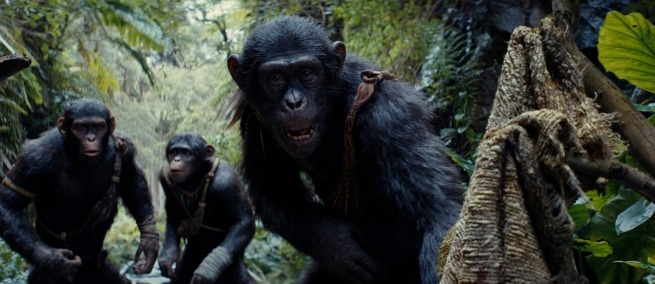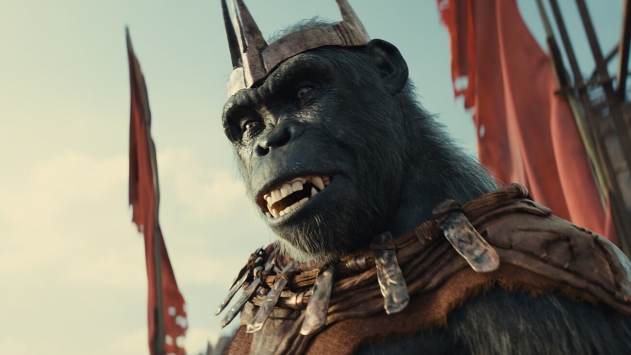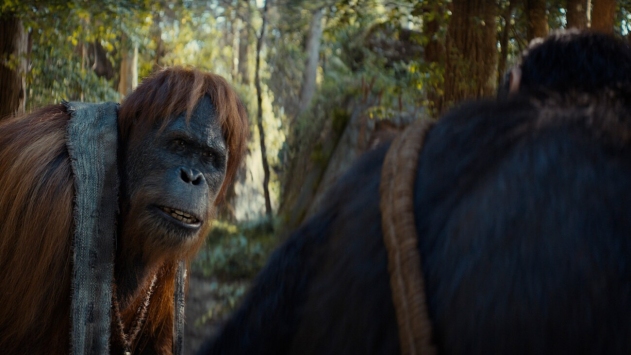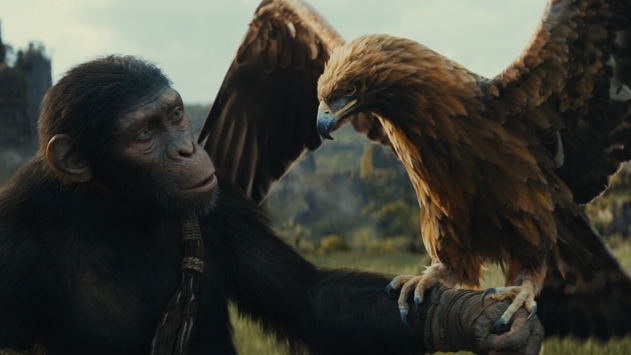

KINGDOM OF THE PLANETS OF THE APES is the newest installment in the PLANET OF THE APES franchise and takes place approximately 300 years after the fall of the chimpanzee leader and series protagonist, Caesar. The new film follows a chimpanzee (Pan troglodytes) named Noa, who is played by Owen Teague. Noa’s village is raided by a rebel group of “apes,” leading to the capture of Noa’s family and community members, and to the death of his father, Koro (Neil Sandilands). Noa promises to bring his family home and sets out beyond the group’s territory to find his clan.
Before going any further, I feel that two important points need to be made. The first is that humans and chimpanzees are both in the great ape family, along with bonobos (Pan paniscus), gorillas (Gorilla), and orangutans (Pongo). All five species of great ape are represented in KINGDOM OF THE PLANET OF THE APES. To be consistent with the film and franchise, which do not consider humans as apes, I will refer to all nonhuman great apes (chimpanzees, bonobos, gorillas, and orangutans) as “apes.” The second point is that all apes are endangered in the wild – with human activities as the largest threat to their survival. In reality, chimpanzees and other apes need our help; we are the only species that can save them. Apes Together Strong.

Proximus Caesar in KINGDOM OF THE PLANET OF THE APES. Photo courtesy of 20th Century Studios. © 2023 20th Century Studios.
In terms of the film’s portrayal of the various apes, I am sorry to break it to fans of the franchise who might have gotten this impression, but Proximus Caesar is not a bonobo (evolved or otherwise). Bonobos are smaller and more gracile than chimpanzees, and the two species differ in their social organization. While a single alpha male is typically in charge of chimpanzee groups (patriarchal), bonobo social groups are led by multiple females (matriarchal). At the age of sexual maturity, bonobo females leave their natal group and emigrate to a new community – forming close bonds with the resident females of the new group. Chimpanzee females also emigrate at the age of sexual maturity, but it is the male-male bonds that are the most important for this species. Based on appearance and behavior, it is more likely that Proximus Caesar is a chimpanzee than a bonobo. It would be great to see the franchise explore the role female bonds play in bonobo sociality, or to include a more accurate representation of bonobos in future films. The only bonobo research center in the world is the Ape Initiative, where you can learn more.
The most bonobo-like character in the film is in fact the fun-loving jokester, Anaya. Bonobos have long, dark faces, with pale eyelids and lips – much like Anaya. Anaya’s jovial (and sometimes risky) attitude, loyalty to his friends, and fear in the face of conflict are all reminiscent of bonobos. As a viewer, you feel great compassion for Anaya. His character brings a curious, playful, and often nerve-wracking energy to the film. Another standout ape in the film is the orangutan, Raka. If only we got to see more of him.

Raka in KINGDOM OF THE PLANET OF THE APES. Photo courtesy of 20th Century Studios. © 2024 20th Century Studios.
Since the original 1968 PLANET OF THE APES film was released, people have been fascinated with the idea of what life would look like if apes were the predominant species on the planet. The franchise has expanded on this concept, touching on captivity, exploitation, and warfare. KINGDOM OF THE PLANET OF THE APES shows us the ultimate reversal of our current existence, with humans being hunted by apes and struggling to survive.
In the new film, Noa encounters a human named Mae (Freya Allan), who is one of the last remaining humans with spoken language. Along with orangutan Raka (played by Peter Macon), Noa helps Mae escape the rebel ape group, saves Mae from drowning in the rapids, and accompanies Mae inside a former human intelligence base – fighting against the other apes. Mae’s distrust of Noa and the other apes, while reasonably warranted, leaves the viewer stunned as she clenches a gun behind her back in the final scene. The filmmakers play with this duality – us vs. them, human vs. ape – throughout the films in the franchise. However, the new film steps into a league of its own.
In addition to obvious advances in CGI, KINGDOM OF THE PLANET OF THE APES brings a refreshingly nonhuman approach to the focal apes of the film. As an expert in great ape social communication, I was blown away by Teague’s portrayal of chimpanzee gestures, body postures, and movements. Teague based his character Noa on a chimpanzee living at the Center for Great Apes in Wauchula, Florida, and his research really shows. Of course, the film keeps true to the franchise, with engaging anthropomorphized apes at the helm. However, it is worth noting the filmmakers’ success in portraying the ape characters as less human-like than previous installments.

Noa in KINGDOM OF THE PLANET OF THE APES. Photo courtesy of 20th Century Studios. © 2023 20th Century Studios.
The film starts with Noa and his two friends, Soona (Lydia Peckham) and Anaya (Travis Jeffery), searching for eagle nests at the top of the canopy. Noa’s group of chimpanzees are unique; they raise and train eagles. Noa’s father, Koro, is the Leader of the Eagle Clan. The thought of a species other than humans keeping birds is both intriguing and terrifying. Humans have long since believed that the ability to harness nature is in our hands alone. We know symbiotic relationships exist between different species in the wild. For example, Oxpeckers clean and eat ticks off of ungulates living in the African Savannah; the birds receive a consistent food supply and the zebras, wildebeests, and other ungulates, are kept free of parasites. Examples of housing, breeding, and training birds, however, do not exist outside of humans. The film does a wonderful job of exploring what this scenario might look like in another species, with the chimpanzees showing great respect for the eagles. Noa and his clan’s relationships with the eagles symbolizes a rich culture which will ultimately lead to their success.
While the filmmakers do understand the power of an eagle’s beak, they ignore the best physical weapon that an ape has – their maxillary canines. Aside from humans, apes have large, sharp canine teeth that they can use to rip apart animal flesh. Researchers have documented male gorillas and chimpanzees killing members of their own kind, with both species being capable of lethally biting another individual. The apes depicted in the franchise would certainly take advantage of this weapon before shooting an arrow or firing a gun. This is also something that sets the apes apart from the humans in the film and could be leveraged in future installments. We are often so focused on what makes humans unique, that we forget about the factors that make chimpanzees, gorillas, and other apes unique.
For humans, it is our ability to communicate and cooperate that makes us so special. It leads to empathy and compassion, results in productive collaborations, and lays the foundation of success for our species. However, group-identity and our ability to cooperate with certain individuals is also responsible for many of the negative things that we associate with being human (coordinated violence, coalitions to promote hate, unified warfare). The concept of us vs. them is ultimately a result of humans’ sophisticated ability to communicate and cooperate. In some ways, it is harrowing to watch the KINGDOM OF THE PLANET OF THE APES story play out – the more human something becomes, the more it hurts and harms members of its own kind.
The ending of the film suggests that the next installment may take us into space – an idea I hope the filmmakers pause on. I personally would like to see how we can clean up this planet of the apes, before jetting off to a new one. The franchise is at a unique point where the filmmakers could forge a new path into the world of great ape cooperation – moving away from the gun-toting, war-leading apes, or the glorification of apes in space. Will it be a group of elder bonobo females that shows us a path to peace?
♦
TOPICS